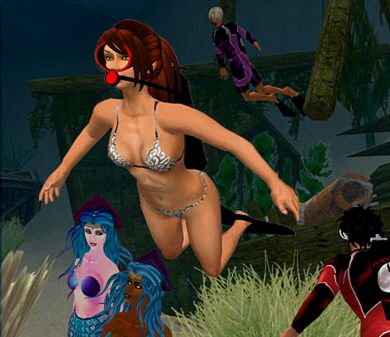
This week we are going to be looking at Rapture, Bioshock, and female involvement in games. The latter is motivated by the weak female stereotype I came across in the game "Lost planet, Extreme Conditions". Which, after playing Bioshock, sucks even more.
I recently read a blog on a game called Imagine: Babyz. (yes, the spelling is intentional) This game is a range brought to us by Ubisoft. It aims to crack the young female market. That market being - get this - fashion, shopping, babies and animals. All the things woman care about, except cooking and cleaning, but these are more of a given, I assume. Who is responsible for this continued stereotyping? Are the woman working in these projects alright with this? The blog does enter into this dimension and the resounding answer is; No! Yet somehow, these products still remain convincingly male. I only wish to raise this in hopes that one day when I have kids, they will be able to play games where male and female characters are better research. Where the idea that boys like; guns, boobs and war. Girls like; shopping, fashion and little things they can control, will not be a valid thought, where games will have leading characters who are strong leaders regardless. Convincing and conscientious. Then again, in this world, the English would probably be able to play rugby and rule the globe. The blog can be viewed at: "http://www.wonderlandblog.com/wonderland/2007/10/ubisofts-imagin.html" Do yourself a favor and read it. Except for the silly part about race.
So, back to ruling the world. Bioshock. It is, to put it easily for those of us who lose focus quickly; Awesome. I loved it. From the beginning to the very end. The cut scenes are few and very far between, but this does not matter. The game is filled of dialog, be it recordings found lying around that tell you of what went wrong, or utopian propaganda spewing out of the 60's looking tellies. The information is bountiful.
And so is the graphics, Oh! what joy, the game has a superb engine. Running on the Unreal engine, it is rather downgradeable. I could run it smoothly on my average machine, with it reminding me at parts of shots from Myst, with vast detailed scenes. However, even these become rough and hard when compared to Bioshock on full graphics. I'm not saying that it looks bad, I don't actually think it can look bad. It only looks less like a Van Gogh and more like a later life Goya. The graphics and the concept is surreal.
Its a city, called Rapture, built under the sea, designed and lead by a man called, Andrew Ryan. He is constantly talking on the televisions and radio stations. Telling you to look out for groups that are fighting against the dream that is Rapture. We enter the scene via a plane crash, and our 'guide' is a friendly Irish sounding bloke who asks us to kindly help him find his family who are trapped in the war ridden city. The story that unfolds is captivating and brilliant. There are many religious and political, all be it old school communism and capitalism, being the everlasting rivals they where in the 1960's and Rapture being as the name implies, an escape from a world riddled with political insecurity. The plot has a great twist and the last battle is epic
After playing the game you realize that "There are many ways to kill splicer". (A splicer is one of the many enemies you have to face). And that is one of the best parts of this game. Throw Tom Clancy's; Splinter Cell and Doom together and you get Bioshock. A game that allows you to work around your enemy by turning the environment against him, or running in, guns a blazing. This is greatly allowed by the fact that genetic modification has been allowed to develop without restraint. Through this you develop 'passive' skills that increase your skills, these are called Tonics. There are different categories here; fighting, shooting and solving tonics. The fighting tonics makes you stronger, faster and more armored, the shooting; increases damage and so forth, lastly, the solving is a part I found very refreshing: Think back ten year maby even more. There was a game called pipes mania, 1989. It was a legend. This has been incorporated into the 'hacking' part of the game. 'Hacking' is the solving part. This means that when you come across a turret or a camera, you can either shoot the hell out of it, or shoot it with an electric current and hack it. Thus, turning it to your side. Here the tonics slow the flow of the water through the pipes, or makes it easier to pick a safe. There are many different tonics, but you can only chose two or three per section.
Being genetically altered also allows you one more ability, you have 'powers' instead of the normal lightning magic or fire magic one finds in a RPG, you now have Plasmids. Making your once defined options of hand grenade or rocket launcher much larger. You can throw lightning, fire, ice or 'bombs' that make your enemies turn against their own. One can jump between guns and plasmids by right clicking, making combos possible. For example, shooting a lightning bolt stuns the enemy, you can then run up to him and beat him with the ever present wrench or open fire without threat of retaliation. There is a rather expansive list of plasmids to chose from. In total there is more than 70 different tonics and plasmids. Plasmids use your Eve, which needs to be gathered in a similar fashion one would gather bullets.
Lastly, the weapons. They are amazing, with each one having three different types of bullets, and then being upgradeable on two counts, damage and speed. The range is true to a FPS, with your shotgun and grenade launcher close at hand. There are unbelievably many ways to approach the game. And this is not even discussing the fact that you have to gather Atom from 'little sisters' who are protected by 'Big brothers'. Atom is the tool used to control the society, it is the energy all of Rapture is run on. And remember: "He who holds the Atom controls Rapture".
Bioshock is truly one of the best games of 2007: The concept is sound and entertaining, the graphics beautiful, the music addictive, and the product flawless. All I'm concerned about is how long it will take for the song, 'momma loves mambo, papa love mambo..' to get out of my head...







